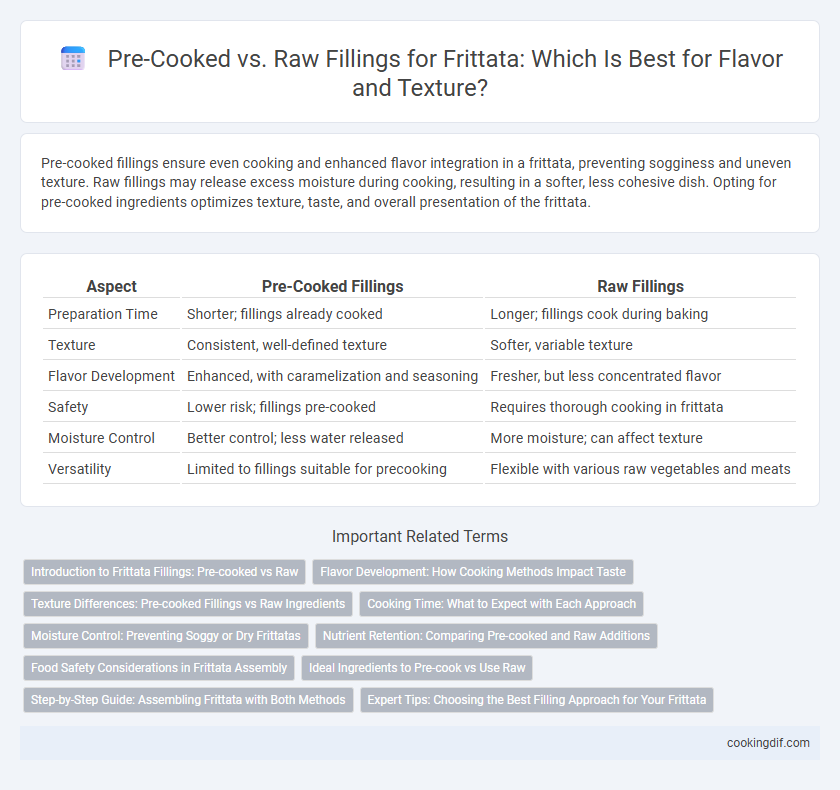Pre-cooked fillings ensure even cooking and enhanced flavor integration in a frittata, preventing sogginess and uneven texture. Raw fillings may release excess moisture during cooking, resulting in a softer, less cohesive dish. Opting for pre-cooked ingredients optimizes texture, taste, and overall presentation of the frittata.
Table of Comparison
| Aspect | Pre-Cooked Fillings | Raw Fillings |
|---|---|---|
| Preparation Time | Shorter; fillings already cooked | Longer; fillings cook during baking |
| Texture | Consistent, well-defined texture | Softer, variable texture |
| Flavor Development | Enhanced, with caramelization and seasoning | Fresher, but less concentrated flavor |
| Safety | Lower risk; fillings pre-cooked | Requires thorough cooking in frittata |
| Moisture Control | Better control; less water released | More moisture; can affect texture |
| Versatility | Limited to fillings suitable for precooking | Flexible with various raw vegetables and meats |
Introduction to Frittata Fillings: Pre-cooked vs Raw
Pre-cooked fillings in frittatas, such as sauteed vegetables or grilled meats, release concentrated flavors and ensure even cooking without excess moisture. Raw fillings, like fresh spinach or diced tomatoes, offer a lighter texture but require careful timing to avoid sogginess and uneven doneness. Choosing between pre-cooked and raw ingredients significantly impacts the frittata's flavor depth, moisture content, and overall texture.
Flavor Development: How Cooking Methods Impact Taste
Pre-cooked fillings for frittatas enhance flavor development by allowing Maillard reactions and caramelization to occur, resulting in richer, deeper taste profiles. Raw fillings, when cooked directly in the frittata, release fresher, more vibrant flavors but may retain a slightly softer texture and less complexity. Choosing pre-cooked ingredients optimizes savory depth, while raw components provide natural brightness, influencing the overall sensory balance of the dish.
Texture Differences: Pre-cooked Fillings vs Raw Ingredients
Pre-cooked fillings in a frittata yield a tender texture with intensified flavors as ingredients like sauteed vegetables or cooked meats release moisture gradually during baking. Raw fillings often result in a firmer texture and less even cooking, as the moisture content varies and requires longer cooking times to soften. The difference in texture is crucial for achieving the classic creamy and cohesive consistency of a well-made frittata.
Cooking Time: What to Expect with Each Approach
Using pre-cooked fillings in a frittata significantly reduces overall cooking time because the ingredients only need to be heated through, ensuring a quicker, more evenly cooked dish. Raw fillings require longer cooking as they release moisture and need to soften, which can extend baking time and impact the texture of the frittata. Expect pre-cooked versions to bake in about 15-20 minutes, while raw fillings may require 25-30 minutes or more to achieve a fully set and properly cooked result.
Moisture Control: Preventing Soggy or Dry Frittatas
Pre-cooked fillings release less moisture compared to raw fillings, ensuring a firmer frittata texture and preventing sogginess. Raw fillings like vegetables contain higher water content that can leach during cooking, potentially resulting in a watery or unevenly cooked dish. Controlling moisture through proper filling preparation maintains a balanced, tender frittata without dryness or excess wetness.
Nutrient Retention: Comparing Pre-cooked and Raw Additions
Pre-cooked fillings in frittatas often exhibit reduced nutrient retention compared to raw additions due to heat-sensitive vitamins like vitamin C and certain B vitamins degrading during initial cooking. Raw vegetables retain higher levels of antioxidants and water-soluble nutrients, enhancing the overall nutritional profile of the frittata when cooked gently. Selecting raw fillings and controlling final cooking temperature optimizes nutrient preservation and maximizes health benefits.
Food Safety Considerations in Frittata Assembly
Pre-cooked fillings in frittata assembly significantly reduce the risk of foodborne illness by ensuring harmful bacteria are eliminated before cooking. Raw fillings require thorough cooking within the frittata to reach a safe internal temperature of 160degF (71degC), critical for eliminating pathogens like Salmonella and E. coli. Proper handling and storage of both pre-cooked and raw ingredients are essential to avoid cross-contamination and maintain food safety standards during frittata preparation.
Ideal Ingredients to Pre-cook vs Use Raw
Pre-cooked fillings such as sauteed vegetables, cooked meats, and caramelized onions enhance a frittata's texture and flavor by reducing excess moisture and ensuring even cooking. Raw ingredients like spinach or tomatoes can release water during baking, potentially making the frittata soggy, so they are best either drained or lightly cooked beforehand. Harder vegetables like potatoes and mushrooms require pre-cooking to soften and integrate fully, while delicate herbs and certain cheeses are ideal to add raw for fresh taste and creaminess.
Step-by-Step Guide: Assembling Frittata with Both Methods
Pre-cooked fillings enhance a frittata's texture by ensuring even cooking and rich flavor integration, requiring a brief saute before adding to the egg mixture to avoid excess moisture. Raw fillings demand careful chopping and must be evenly distributed for consistent cooking, as the frittata will cook through in the oven or stovetop without pre-softening. Combining both methods involves layering pre-cooked vegetables or meats first, then sprinkling raw fillings on top, allowing for a balanced blend of textures and flavors in the final dish.
Expert Tips: Choosing the Best Filling Approach for Your Frittata
Pre-cooked fillings for frittatas enhance flavor depth and prevent excess moisture that can compromise texture, ensuring a firm and well-set dish. Raw fillings, while convenient, often release water during cooking, potentially leading to a soggy frittata and uneven cooking. Expert chefs recommend pre-cooking ingredients like vegetables and meats to intensify taste and maintain optimal consistency for a perfectly balanced frittata.
Pre-cooked fillings vs raw fillings for Frittata assembly Infographic

 cookingdif.com
cookingdif.com